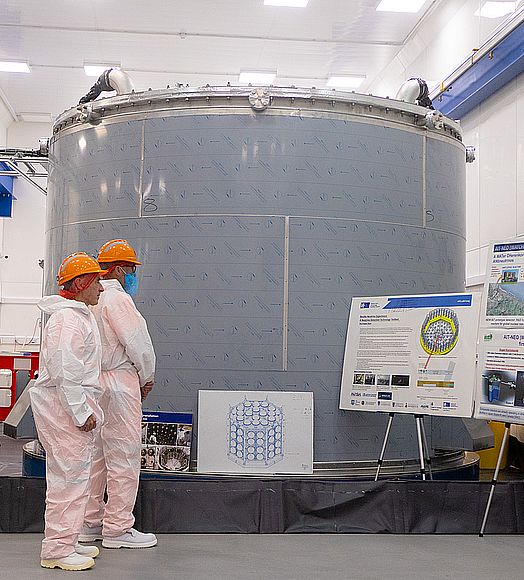Having been contacted by John McCue at short notice, an opportunity arose for a fellow society member to accompany him on a visit to the Dark Matter facility located down Boulby Mine. John is in the process of writing an article for the Astronomy Yearbook on the latest developments on detecting Dark Matter at Boulby and having contacted the Mine received an invitation to see for himself.
As mentioned, it was short notice and Mark, who was unable to make it himself, sent out an email SOS to those members who may have been able join John. It would be an early start, the lucky visitor having to be at Boulby Mine for 07:15hrs. It was strictly a 'first come - first down the mine' scenario. Richard Randle was first to positively respond, delighted to accompany John on the visit.
Here then is a brief report by Richard on the day’s proceedings.
Booted and suited, fully inducted and checked over, John and I waited with trepidation as the mine lift doors opened right on 9:30am, we were about to descend almost 1100 metres below ground. Salt crystals glinted momentarily as our head-torches scanned the tunnel for any stalagmites, natural growing trip hazards on our 15-minute hike in hot conditions to the Underground Laboratory.
The size of two double buses nose to nose, the Lab provides unique opportunities in the UK to carry out real science, mostly to do with sub-atomic particles, those not yet detected, only hypothesised - weakly interactive massive particles, or WIMPS, the most abundant component making up dark matter material! Their detection on Earth has so far eluded the scientific community - including those at Boulby, but new experiments are forthcoming. This was the main purpose of our visit.
You’d be disappointed if you were expecting flashing gizmos and white-jacketed scientists with clip boards, very much the opposite! The information boards headlining each experiment/ project as one walked between the roughly 6x6’ plots did remind me of a science museum - but without the twiddly knobs! They ranged from Muon detectors - Aquamuography for Tsunami early warning detection, to BUTTON or Boulby Underground Testbed Towards Observing Neutrinos that allows the detection of potentially non-compliant nuclear facilities.
During our tour I couldn’t help thinking one would have to have a high-level interest in physics and statistics, ranging from colourful heat maps to logarithmic scales, to be able to decipher the science behind each of these projects. We were in good hands; our tour guided ably by host Johnny Gutteridge of UK Research and Innovation. We weren’t the only ones looking to gain an insight into the methods of detection, in between our guided tour, Johnny had to break off for a live link with science teachers from various secondary schools, carrying out a similar tour but on a whirlwind scale. Perhaps, if this was going to be a showcase to entice future students for STEM subjects, a separate narrative pitched at GCSE level was sorely needed!
Anyhow, detection of dark matter. This makes up 85% of the material in the entire universe which we have yet to detect. But how do we know it exists? Using Newton’s Laws, a satellite’s radial velocity is accurately predicted by knowing its mass and distance from the larger body it is rotating around. However, on a macro scale, bodies such as star clusters do not appear to follow the same gravitational rules around the galaxy’s core if the distance between the two are known. In all cases they travel faster than predicted. This is due to the additional mass contributed by the dark matter we cannot see.
And why do we need to know? Apart from the old mantra “because it’s there”, there is an inextricable link between macro and micro-physics. By understanding and explaining what goes on in our skies, will reaffirm the fundamentals of physics, provide a pathway to any changes in our existing laws and ultimately raise the likelihood of the survival of mankind through space travel.
The development and testing of dark matter instruments have been ongoing for over 20 years at the mine. Selected as an ideal candidate for such detection, the depth of the mine, one of the deepest in Europe guarantees the elimination of cosmic radiation most likely to interfere with any meaningful results. First and second-generation detectors are already relics, NIAID, DRIFT and ZEPLIN - confined to the Surface Building as fancy coffee tables.
The focus is now on the construction of XLZD. It’s a collective effort by the Xenon, Lux, Zeplin, and Darwin collaborations, using Xenon liquid gas - a noble gas with high stability. Its construction at Boulby will be spread over 2 stages, with stage 1 already financed allowing smaller scale, pilot studies to be carried out from 2028. Based on the results and finance pulled in from their success it is hoped stage 2 will be developed at Boulby, aimed to be completed by 2033 with the full-scale 60 tonne plant to be built 200m below the current underground lab.
Considering its sibling, LUX-ZEPLIN in Dakota, USA, upon which XLZD is designed is just 7 tonnes, highlights the enormity of the task. Stage 1 will also become a showcase for enticing local apprentices with STEM backgrounds, so local Government funding cannot be ruled out. It is an exciting prospect - and all on our doorstep.
Richard will be giving a presentation of his day in the DM lab at the WDAS November meeting - with assistance by Mark on Dark Matter itself.
- Log in to post comments





